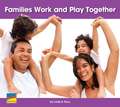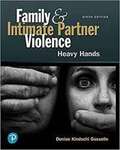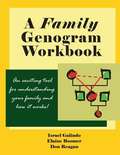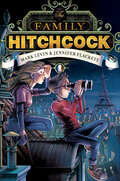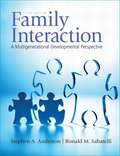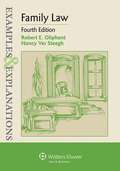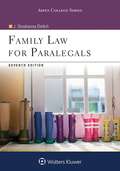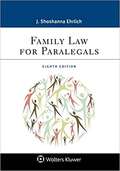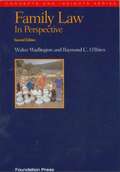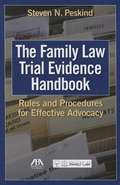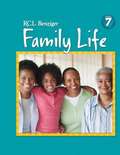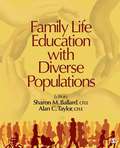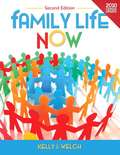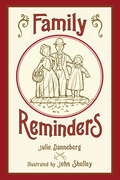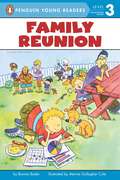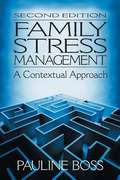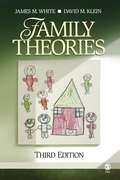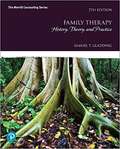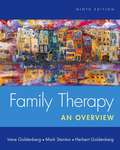- Table View
- List View
Family And Intimate Partner Violence: Heavy Hands
by Denise GosselinFor courses in domestic violence, family violence, and victimology. <P><P> The authoritative introduction to family violence Family and Intimate Partner Violence: Heavy Handsis an authentic introduction to the crimes of family violence, covering offenders and offenses, impact on victims, and responses of the criminal justice system. Comprehensive yet easy to understand, this established text is essential reading for students considering careers in criminal justice, victim advocacy, social work, or counseling. Gosselin draws on extensive field experience and real¿ examples to explain abuse and its effects on survivors. The 6th edition includes a new chapter on adolescent and young adult victimization, as well as updates to topics of interest such as intimate partner violence, asylum law, and theoretical perspectives.
Family Fun (Fountas & Pinnell Classroom, Guided Reading Grade 1)
by Phoebe Stratton Lizzy RockwellNIMAC-sourced textbook
A Family Genogram Workbook
by Israel Galindo Elaine Boomer Don ReaganA Family Genogram Workbook, by Israel Galindo, Elaine Boomer, and Don Reagan, is an easy to use, but powerful, guide to understanding your family and how it shaped you. This workbook will take you step-by-step to learn how to create your own family genogram. A genogram is an exciting tool for understanding and interpreting family history and relationships. By working through various exercises and activities in A Family Genogram Workbook you will gain insight into your family and your place in it. The workbook has four chapters. The first, a tutorial, shows readers, step-by-step, how to create their own family genogram so that they can quickly reap the benefits of this powerful tool for understanding family emotional process. The workbook format contains work pages so the reader can create a genogram right in the book. Subsequent chapters provide basic information on how to interpret and how to use the genogram. The chapter titled The 20 Questions to Ask About Your Family will help readers focus on key issues related to family emotional process. By working through various exercises and activities in A Family Genogram Workbook readers will gain insight into their families, how they work, and their place in it. Along the way, readers will also acquire an understanding of basic Family Systems Theory concepts and terminology. This resource is suitable for courses on family systems, social work practice, individual or group study, marriage and family retreats or workshops, for premarital counseling with couples or blended families, coaching relationships, or for personal use.
The Family Hitchcock
by Mark Levin Jennifer Flackett“An entertaining and high-energy story of mistaken identities and international intrigue. The ample suspense and feisty family dynamics ought to keep readers invested.” — Publishers Weekly“Preposterous fun with genuine touches of emotion about family dynamics. Fans of Polly Horvath’s Everything on a Waffle should enjoy this comical romp.” — School Library Journal
Family Interaction: A Multigenerational Developmental Perspective
by Stephen A. Anderson Ronald M. SabatelliExamines families - their challenges and successes - as they move through the life course. Family Interaction takes a family systems and a multigenerational, developmental framework. This text looks at the major conceptual models used to understand the patterns and interactional dynamics that operate in families. It provides readers with an overview of the basic tasks that all families must execute regardless of their particular composition or living situation and, at the same time, offers readers an appreciation of the variety and uniqueness in the ways in which each family develops its patterns of interaction.
Family Law: Examples And Explanations
by Robert E. Oliphant Nancy Ver SteeghEmploying the trusted Examples & Explanations format, Examples & Explanations: Family Law, Fourth Edition, offers a cutting-edge study aid that will be an asset to any family law class.
Family Law For Paralegals (Aspen College)
by J. Shoshanna EhrlichFamily Law for Paralegals, 7E is a comprehensive text for family law, offering complete coverage of the basics of family law, combined with historical context and insight into topics of current interest. This thoughtful and carefully written textbook offers the nuts-and-bolts of the law, framed in historical context and include exposure to some of the most dynamic issues in family law today. The text’s comprehensive coverage includes basic coverage of the issues of marriage and divorce, as well as cutting-edge issues such as non-marital families, child abuse and neglect, child support and custody, and same-sex marriage.
Family Law for Paralegals (Aspen Paralegal)
by J. Shoshanna EhrlichThe Eighth Edition of Family Law for Paralegals continues to provide complete coverage of traditional family law topics with historical context and dynamic cutting-edge issues such as non-marital families, child abuse and neglect, and same-sex marriage. <p><p> J. Shoshanna Ehrlich s balanced approach prepares students to handle the work of a paralegal through examples, assignments, and sample forms that mirror legal practice.
Family Law in Perspective (Second Edition)
by Walter WadlingtonThis readable and authoritative text is designed for law students as a supplement in a basic family law course. The manageably-sized text approaches family law conceptually with coverage extending over a broad area. The Second Edition reviews the multiple state decisions and statutes occurring since the first edition, and integrates them with what has previously been the law. So too, the new edition analyzes the recent enactments of Congress and decisions by the federal judiciary that affect family law. The result of this integration of federal and state approaches is an up-to-date perspective on such issues as private ordering among adults, same sex marriage, relationships mirroring the benefits of marriage, abortion, child support and custody, relocation, domestic violence, and an increasing awareness of the international ramifications of support and custody orders. Procreation and the biological revolution have radically altered the establishment of paternity and maternity and increased scrutiny of the new reproductive technologies available. And regrettably, states and Congress continue to struggle with child abuse and neglect, termination of parental rights, and children residing in foster care or kinship care. Many of these topics are highlighted with a brief footnote so as to offer the reader a portal into further research into that particular subject. The new edition offers an explanation of what has occurred in the past and a rational suggestion as to the trends of the future.
Family Law Trial Evidence Handbook: Rules and Procedures For Effective Advocacy
by Steven N. Peskind American Bar Association Section Of Family Law StaffBeing a trial lawyer requires a working knowledge of the rules of evidence. Based upon the author's years of family law practice, this practical handbook is useful for all family law trial lawyers, regardless of whether they practice in a state that uses a variation on the Federal Rules or a common law body of rules on evidence. Topics range from hearsay, authentication of writings, and examination of witnesses to tendering exhibits, procedures for streamlining admission of evidence, and requests to admit facts and genuineness of documents.
Family Life 7, Student Edition
by David ThomasThe book has been designed to help the reader and the reader's family love your way through life, by following the way of Jesus.
Family Life Education: Integrating Theory and Practice
by Michael J. Walcheski David J. BredehoftThe twofold object of the book "Family Life Education: Integrating Theory and Practice 2nd edition" is to provide a text for the preparation of family life educators and a resource for the practice of family life education. It addresses many of the issues involved in the training of family life educators and the needs of the practicing family life educator.
Family Life Education with Diverse Populations
by Sharon M. Ballard Alan C. TaylorFamily Life Education with Diverse Populations is a T2 for courses in Family Life Education. Family Studies and Social Work students often go through the additional certification of becoming Family Life Educators (FLEs). As a family life educator, the student will help educate families in and outside the traditional classroom environment on how to strengthen relationships in the home and foster positive individual, couple and family development. Such education comprises many topics, including marriage education, parenting skills, anger management, to strategies in adjusting to divorce. This book takes the content delivered in courses on FLE a step further by examining and presenting key strategies for working with diverse populations. Diverse is defined broadly in terms of race and ethnicity, but also by setting, such as military families, rural families, families with loved ones in prison, and more. The book is unique in defining the group and presenting their strengths, and then prescribing treatments and strategies for working with each group. In addition, the book takes an evidence based practice approach and demonstrates proven strategies in working with the populations listed above. Sharon M. Ballard, Ph. D. , CFLE, CFCS: is an Associate Professor in the Department of Child Development and Family Relations at East Carolina University. Alan C. Taylor, Ph. D. CFLE: is an Assistant Professor in the Department of Child Development and Family Relations at East Carolina University.
Family Life Now 2nd Edition
by Kelly J. WelchA candid and thoughtful conversation about family life. Welch's text combines the personal touch and scholarly expertise of an outstanding teacher. Family Life Now Census Update 2e explores the ways that family members and intimate partners interact, and examines how families adapt to stresses, changes, and everyday challenges. As products of our families of origins, who we are and who we become is influenced by our family lives, a central theme woven throughout the book. This book follows the Family Life Education framework to examine marriages, families, and intimate relationships. Throughout the text, theories from the fields of sociology, family studies, psychology, lifespan human development, and other social sciences are integrated so that they can be applied to real life situations. The text also presents enough biological science to explain some of the physical realities of who we are and why we behave as we do. The Census Update program incorporates 2010 Census data into a course-simply and easily. The components of the Census Update Program include an updated census edition with all charts and graphs-to reflect the results of the 2010 Census.
Family Reminders
by Julie DannebergIn the late 1800's ten-year old Mary McHugh's world is shattered when her father is injured in a mining accident. Mary's love for her father and her desperation to get life back to "normal" push her to take a chance that restores her father's spirit and also provides income for the family so they don't have to move.
Family Reunion (Penguin Young Readers, Level 3)
by Bonnie BaderGary Graff doesn't want to go to his family's boring reunion, but when he surveys his family members to finish his math homework-a graphing assignment-Gary learns a lot about graphing and his family-and has a lot of fun, too!
Family Stress Management: A Contextual Approach (Second Edition)
by Pauline BossIn this Second Edition, the author continues to explore both the larger context surrounding families and stress and the inner context, which includes perceptions and meanings. The author emphasizes the need for a more general contextual model of family stress and crises than other models. The goal is to provide a framework for students and professionals engaged in helping families learn how to manage their stress.
Family Theories (Third Edition)
by James M. White David M. KleinBuilding upon the success of two previous bestselling editions, the Third Edition of Family Theories continues to be the ideal resource for readers wishing to develop an understanding of sophisticated ideas about families and marriages. Authors James White and David Klein have updated and revised each chapter based on readers’ suggestions and on developments in the area of family sociology and family studies. An incisive, thorough introduction to current and traditional theories of the family, this text balances the diversity and richness of a broad scope of scholarly work. New to the Third Edition Starts with a reorganized introductory chapter: The opening chapter has been restructured for increased clarity and to offer a better guide to utilizing theory to guide research and practice. Introduces a new chapter: Previous editions included seven major theoretical frameworks to explain variation in family life. The Third Edition welcomes the addition of an eighth framework on functionalist theory. Includes material on postmodernism: By placing information on postmodernism within the chapter on the feminist framework, the authors allow readers to see more clearly how these two intellectual movements relate to the study of families. Offers updates throughout: Significant additions to the “Variations” section of all chapters have been made to capture new theoretical developments. Restores several meta-theories: Deleted from the last chapter in the previous edition, several meta-theories, dealing with the type of causation, treatment of time, and the level of analysis, have been added back in this new edition. Intended Audience This text is designed for advanced undergraduate and graduate courses such as Family Theories, Family Systems & Theory, and Sociology of the Family in departments of family studies, sociology, and human development
Family Therapy: History, Theory, and Practice
by Samuel GladdingFamily Therapy: History, Theory, and Practice covers all aspects of working with couples and families. Grounded in evidence-based practice and the rich theoretical background of marriage and family therapy, the text presents important background information on healthy functioning families of all different compositions, includes an overview of how individual and family life cycles intertwine, and concretely and clearly illustrates (with a wealth of examples) the evidence-based interventions used in working with families that need counseling. <p><p> Thoroughly updated with over 240 new citations, the 7th Edition has added separate chapters on Psychodynamic Family Theories, Bowen Family Systems Theory, Solution-Focused Brief Therapy, and Narrative Family Therapy.
Family Therapy: An Overview Ninth Edition
by Herbert Goldenberg Irene Goldenberg Mark StantonCompletely up-to-date, this engaging and practice-oriented text is your complete resource to help students master the many facets of family therapy. In this ninth edition, the authors provide practice-oriented content in a more concise format that will help students become empathic and effective family therapists. New material focuses on how students can practice systemic thinking and on how to develop core competencies in family therapy. There is also increased attention to LGBTQ families and alternative forms of family life, and to gender, culture, and ethnic considerations. Color-coded boxes highlight key aspects of family therapy, such as family diversity, evidence-based practice research, "Thinking Like a Clinician" student exercises, case studies, clinical notes, and therapeutic encounters.

